The origins of the massive and sometimes controversial Queen Elizabeth class carrier programme lie in the 1998 Strategic Defence Review.
The review re-evaluated every weapon system (active or in procurement) with the exception of the Eurofighter Typhoon and the Vanguard-class ballistic missile submarines.
The report identified that aircraft carriers offered the following:
- Ability to operate offensive aircraft abroad when foreign basing may be denied.
- All required space and infrastructure; where foreign bases are available they are not always available early in a conflict and infrastructure is often lacking.
- A coercive and deterrent effect when deployed to a trouble spot.
The report concluded:
“The emphasis is now on increased offensive air power, and an ability to operate the largest possible range of aircraft in the widest possible range of roles. When the current carrier force reaches the end of its planned life, we plan to replace it with two larger vessels.”
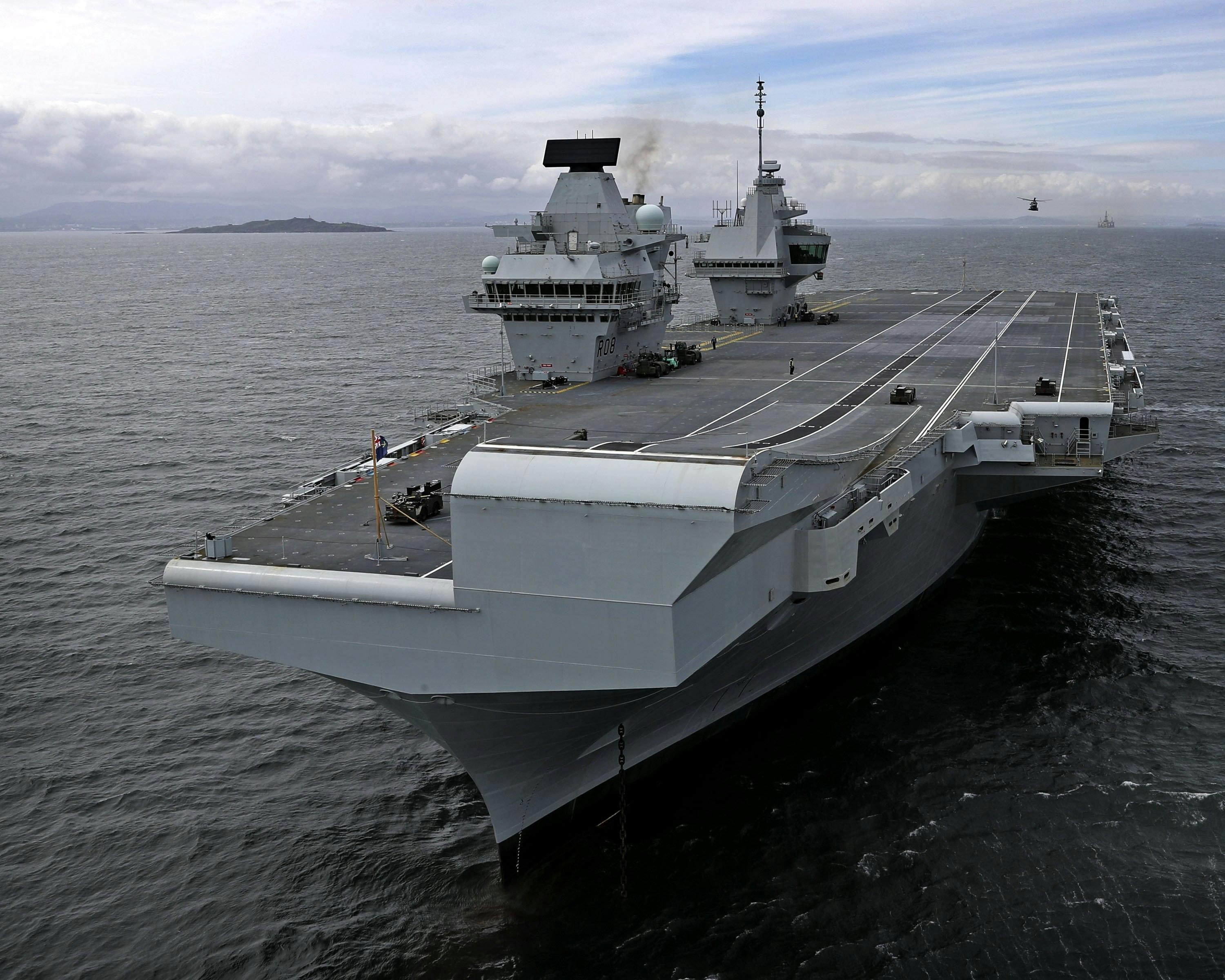
In November 2004, while giving evidence to the House of Commons Defence Committee, First Sea Lord Admiral Sir Alan West explained that the sortie rate and interoperability with the United States Navy were factors in deciding on the size of the carriers and the composition of the carriers’ air-wings:
“The reason that we have arrived at what we have arrived at is because to do the initial strike package, that deep strike package, we have done really quite detailed calculations and we have come out with the figure of 36 joint strike fighters, and that is what has driven the size of it, and that is to be able to deliver the weight of effort that you need for these operations that we are planning in the future.”
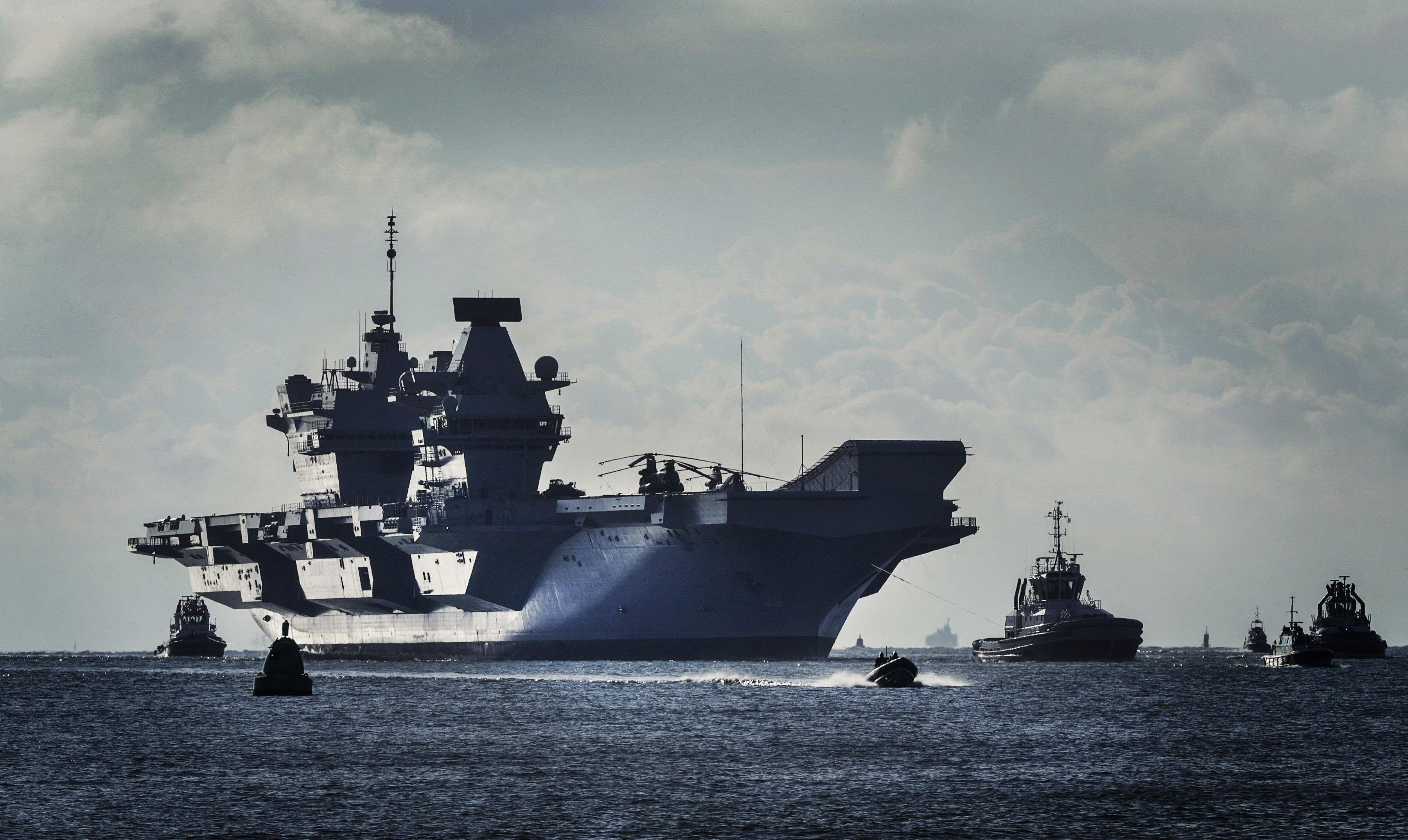 The Queen Elizabeth Class aircraft carriers will be the largest surface warships ever constructed for the Royal Navy and will represent a significant increase in capability. The vessels will be utilised by all three branches of the UK Armed Forces and will provide eight acres of sovereign territory. Both ships will be versatile enough to be used for operations ranging from high intensity conflict to providing humanitarian aid and disaster relief.
The Queen Elizabeth Class aircraft carriers will be the largest surface warships ever constructed for the Royal Navy and will represent a significant increase in capability. The vessels will be utilised by all three branches of the UK Armed Forces and will provide eight acres of sovereign territory. Both ships will be versatile enough to be used for operations ranging from high intensity conflict to providing humanitarian aid and disaster relief.
The class will have increased survivability as a result of the separation and distribution of power generation machinery throughout each ship. The class has been designed with twin islands, which separates the running of the ship from the flying operations resulting in greater visibility of flying operations.
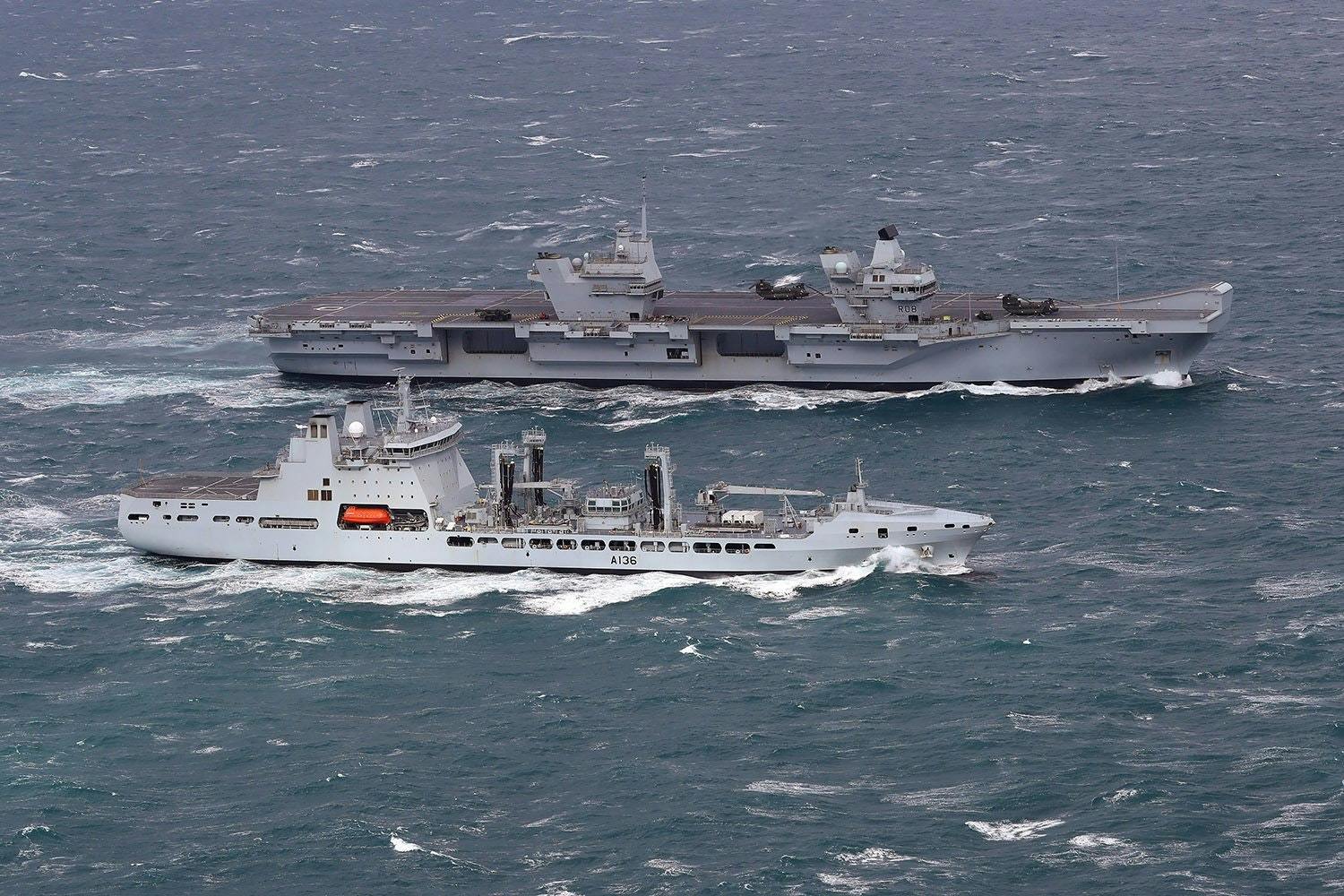 Instead of a traditional single island, the has two smaller islands. The forward island is for ship control functions and the aft (FLYCO) island is for flying control.
Instead of a traditional single island, the has two smaller islands. The forward island is for ship control functions and the aft (FLYCO) island is for flying control.
The reason for two bridges is, simply put, due to the gas turbine exhausts. The design would have either had two small islands or one large, long island. The two smaller islands were chosen. The location and alignment of the islands are based around the 2.4 metre diameter gas turbine exhausts which were pre-fitted in the island and below in the ship superstructure.
Advantages of the two island configuration are primarily increased flight deck area and reduced air turbulence. Flight control in the aft island is positioned perfectly for aircraft approaches and deck landings.
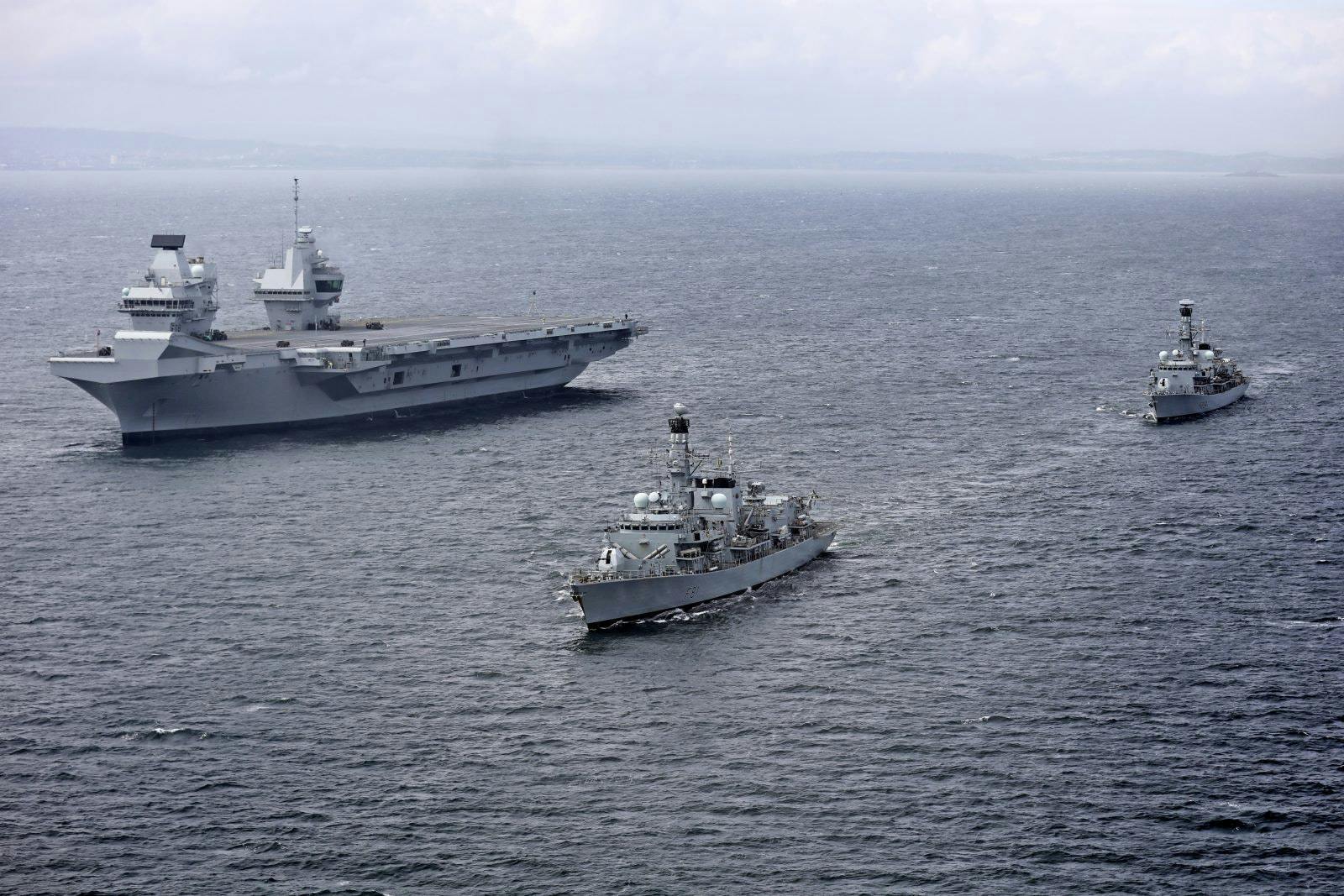
Surprisingly for their sheer scale, each ship will only have a total crew of 800, only increasing to the full complement of 1,600 when the air elements are embarked. This is made possible by extensive automation of many systems.
Before we examine the vessels in depth, let’s just make sure we’re up to speed with the very basics, don’t worry if you forget as there will be a short guide at the end!
The vessels were originally expected to displace about 65,000 tonnes, however as construction continued, the revised estimate of 70,600 tonnes was revealed by the Royal Institute of Naval Architects.
They are built a Short Take-Off and Vertical Landing (STOVL) configuration, deploying the Lockheed Martin F-35B, that simply means they’ll use a ramp to launch aircraft rather than a catapult.
Facilities for crew include a cinema, gym areas and four galleys manned by sixty-seven catering staff. There are four large dining areas, the largest with the capacity to serve 960 meals in one hour. There are eleven medical staff for the eight-bed medical facility, which includes an operating theatre and a dental surgery. There are 1,600 bunks in 470 cabins, including accommodation for a company of 250 Royal Marines with wide assault routes up to the flight deck.

The carrier’s radars will be the BAE Systems S1850M for long range wide area search, and the BAE Systems Artisan 3D maritime medium-range radar and navigation radar. The S1850M has a fully automatic detection and track initiation that can track up to 1,000 air targets at a range of 400 kilometres. Artisan can “track a target the size of a soft ball moving at Mach 2 at very low levels over 35 kilometres away”. The carriers will also be fitted with a Glide Path Camera to assist with aircraft operation.
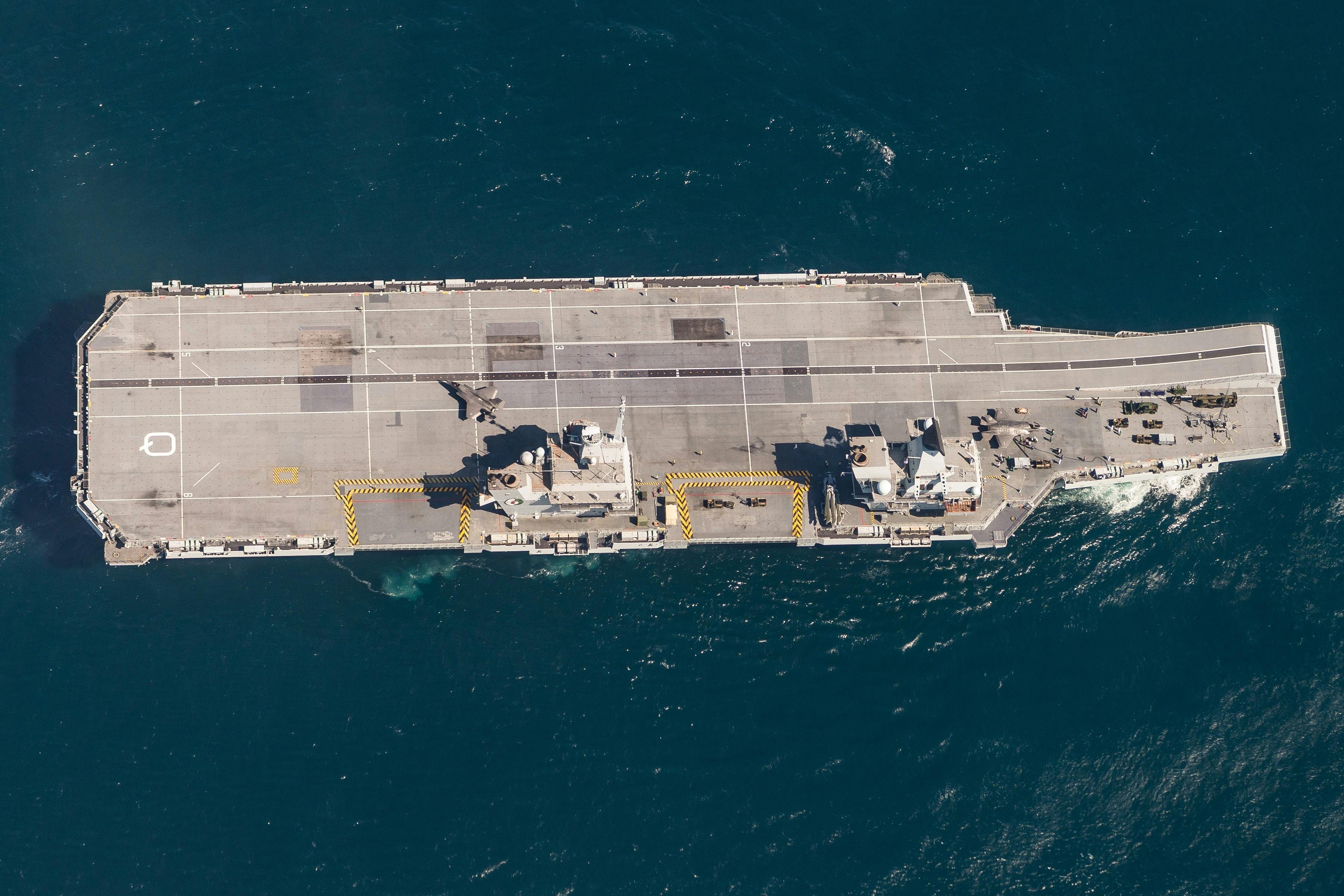 As for propulsion and somewhat understandable given the overwhelming public and news media reaction to the slightest of cost increases, the MoD has decided not to use nuclear propulsion because of its high cost and has chosen a propulsion system based on Rolls-Royce’s integrated electric propulsion system. The propulsion system will consist of two Rolls-Royce Marine 36MW MT30 gas turbine alternators, providing over 70MW and four diesel engines providing approximately 40MW, with the total installed power approaching 110MW.
As for propulsion and somewhat understandable given the overwhelming public and news media reaction to the slightest of cost increases, the MoD has decided not to use nuclear propulsion because of its high cost and has chosen a propulsion system based on Rolls-Royce’s integrated electric propulsion system. The propulsion system will consist of two Rolls-Royce Marine 36MW MT30 gas turbine alternators, providing over 70MW and four diesel engines providing approximately 40MW, with the total installed power approaching 110MW.
Now for perhaps the most complex system, the munitions handling system. It is something truly innovative in the Queen Elizabeth class, it accomplished using a highly mechanised weapons handling system (HMWHS). This is a first naval application of a common warehouse system. The HMWHS moves palletised munitions from the magazines and weapon preparation areas, along track ways and via several lifts, forward and aft or port and starboard. The tracks can carry a pallet to magazines, the hangar, weapons preparation areas, and the flight deck. In a change from normal procedures the magazines are unmanned, the movement of pallets is controlled from a central location, and manpower is only required when munitions are being initially stored or prepared for use. This system speeds up delivery and reduces the size of the crew by automation.

When I toured the vessel in December I was taken aback by the sheer scale of the HMWHS, spaces within the magazine and the level of protection this system has from combat damage. The system was massive in scale, easily the size of a medium supermarket and served by a complex rail system. Needless to say, I managed to trip over it!
Something often overlooked in these types of vessels is there ability to launch small boats, the Queen Elizabeth class have a number of boat bays on the sides of the vessels inside the sponsons, capable of deploying boats by lowering them down into the water, to ferry personnel around, either from ship to ship or between ship and port. The necessity of this is evident when you realise that the scale of these vessels mean that it will not be able to dock at many ports.
The UK is committed to both the F-35 and the Queen Elizabeth Carrier programmes, both of which are on track to enter initial maritime operating capability in December 2020 as planned. Queen Elizabeth will commence sea trials in 2017, and UK F-35 aircraft will be used for first of class flying trials in 2018.
What will the vessels carry?
The term now used for the carriers embarked squadrons is ‘Carrier Air Wing’ (CVW). The vessels are capable of deploying a variety of aircraft in large numbers, up to a maximum in the upper fifties in surge conditions.

Captain Jerry Kyd, former commander of HMS Queen Elizabeth, commented on the initial deployment and the gradual increase in air wing numbers:
“We are constrained by the F-35 buy rate even though that was accelerated in SDSR in 2015, so initial operating capability numbers in 2020 are going to be very modest indeed.
We will flesh it out with helicopters, and a lot depends on how many USMC F-35s come on our first deployment in 2021. But by 2023, we are committed to 24 UK jets onboard, and after that it’s too far away to say.”

In addition to the joint force of Royal Air Force and Royal Navy F-35Bs and their pilots, the air wing is expected to be composed of a ‘Maritime Force Protection’ package of nine anti-submarine Merlin HM2 and four or five Merlin for airborne early warning; alternatively a ‘Littoral Manoeuvre’ package could include a mix of RAF Chinooks, Army Apaches, Merlin HC4 and Wildcat HM2.
It is my understanding that vessel would still carry at least one F-35 squadron aboard in such circumstances to offer air defence as well as support to the helicopter assault activities.
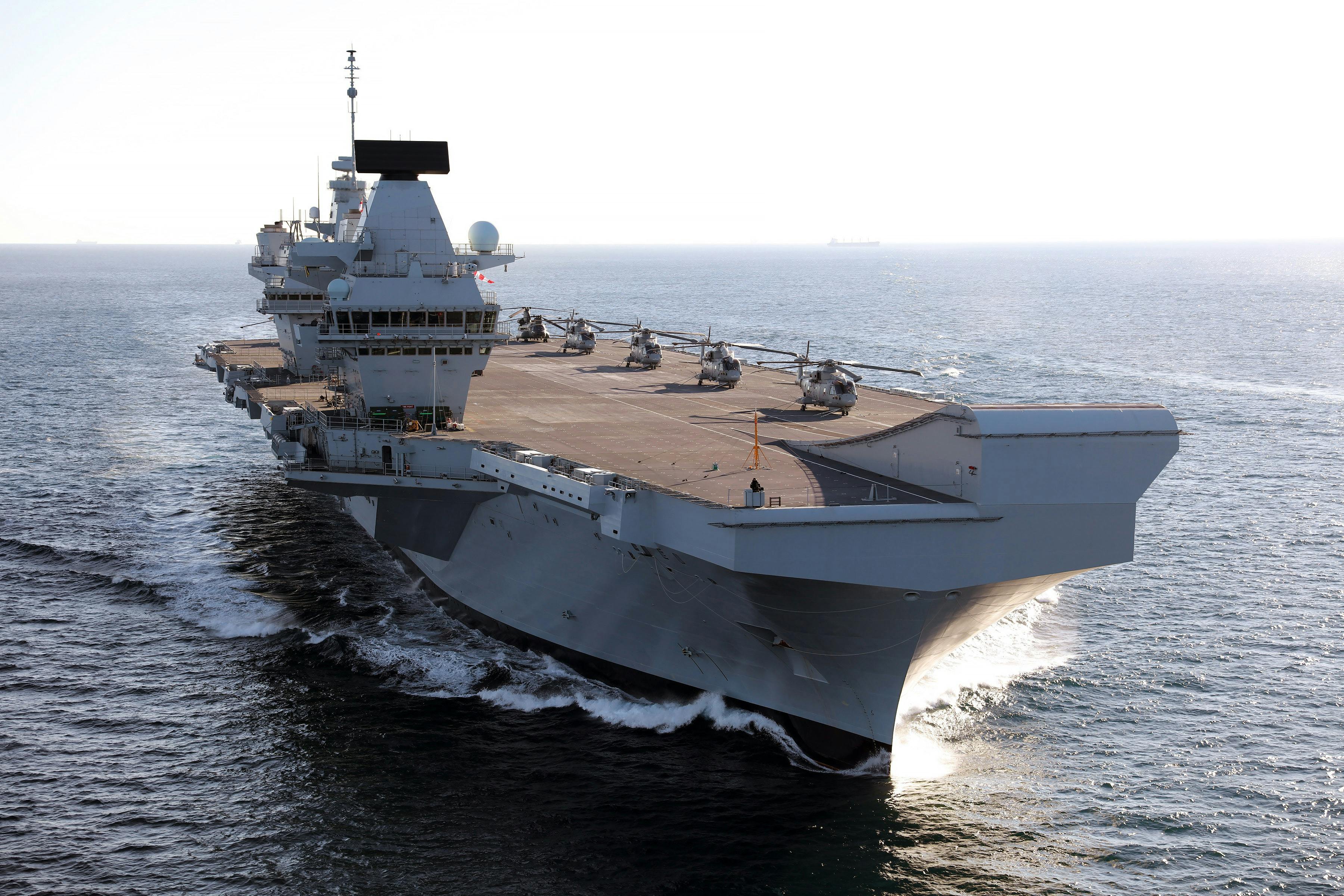 The Crowsnest AEW&C aircraft will come from a number of the embarked Merlins (any of which can be fitted with the sensor package), the number again scaling with requirements.
The Crowsnest AEW&C aircraft will come from a number of the embarked Merlins (any of which can be fitted with the sensor package), the number again scaling with requirements.
Around the time the first carrier deploys operationally, the UK will have 42 F-35 aircraft, with 24 being front-line fighters and the remaining 18 will be used for training (at least 5 on the OCU), be in reserve or in maintenance.
Uniquely for a vessel of this type, it will be common to see the jump-jet F-35B appear to land conventionally. This is a process called Shipborne Rolling Vertical Landing (SRVL). It is a process designed to land jump-jet aircraft that uses both the vertical thrust from the jet engine and lift from the wings, thus maximising the payload an aircraft can return with and stopping the financial waste that comes with dropping expensive weaponry in the sea in order to land vertically.

SRVL landing is under development for use with the F-35B when it enters service in 2018. Rolling landings will enable the F-35B to land on these carriers with an increased weapon and fuel load and will use the aircraft’s computer controlled disc brakes. However, a number of defence analysts have suggested that operational SRVL landings may only be possible within a limited range of sea states and weather conditions.
How many sorties per day?
Aircraft Carrier Alliance Chief Engineer, Martin Douglass said:
“The Queen Elizabeth Class can fly 72 fast jet sorties per day – which can be increased if needed – and will give the UK a world class carrier strike capability for many years to come. She also has increased survivability because of the separation and distribution of power generation machinery throughout each ship.
The ship’s Artisan radar can track up to 800 potential targets at the same time and cut through radio ‘clutter’ generated by the equivalent of 10,000 mobile phones. The long range radar can track up to 1,000 contacts across a 250 mile radius both in the air or at sea. It’s an application of technology that’s already been proven on the Type 45s, but this time is linked to the Carrier’s organic capability to control a wide area of air and sea.”
The Queen Elizabeth class mark a change from expressing carrier power in terms of number of aircraft carried, to the number of sortie’s that can be generated from the deck. The class is estimated to be able to sustain a maximum sortie generation rate in surge conditions of up to 110 sorties per day according to an engineer we spoke to when on-board HMS Queen Elizabeth, but this was just an estimate after all.
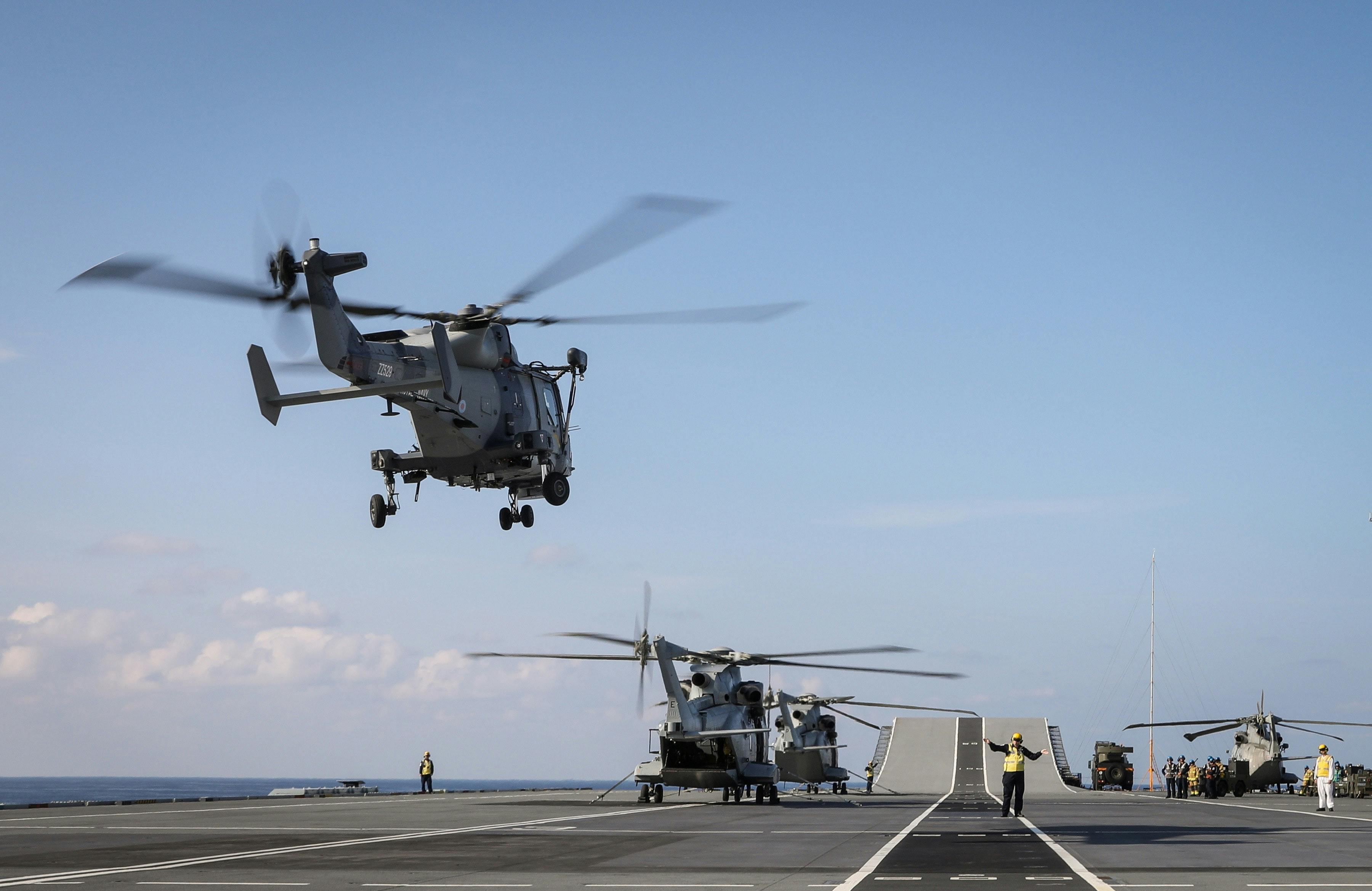 The Key Numbers:
The Key Numbers:
- The project to build HMS Queen Elizabeth and sister ship HMS Prince of Wales cost more than £6 billion.
- The aircraft carrier weighs 70,600 tonnes and has a top speed of 25 knots (this however has been exceeded comfortably).
- Its flight deck is 280 metres long and 70 metres wide – enough space for three football pitches.
- There are 364,000 metres of pipes inside the ship.
- Both HMS Queen Elizabeth and HMS Prince of Wales will keep 45 days’ worth of food in its stores.
- The entire Ship’s Company of 800 can be served a meal within 90 minutes – 45 minutes when at action station.


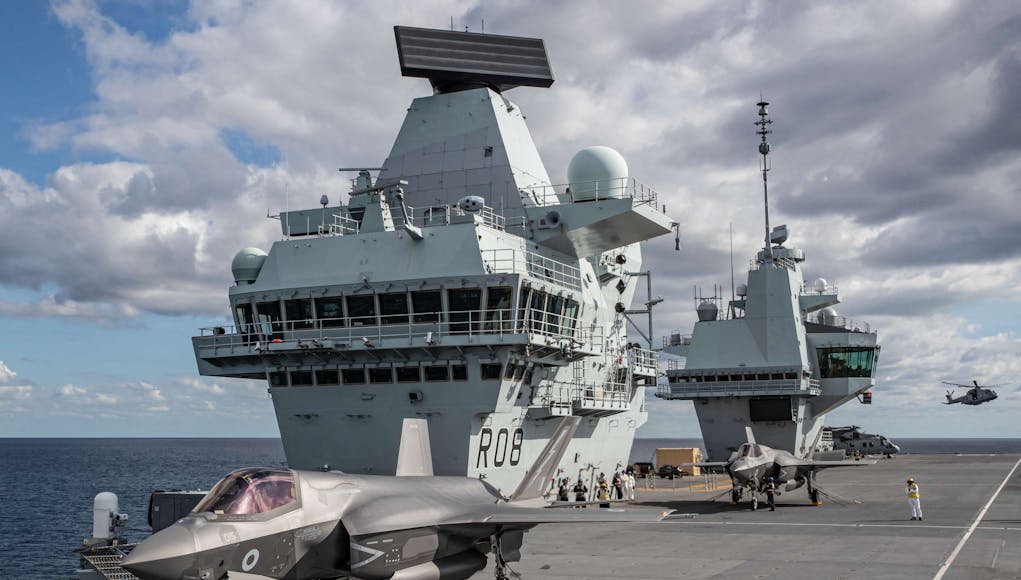
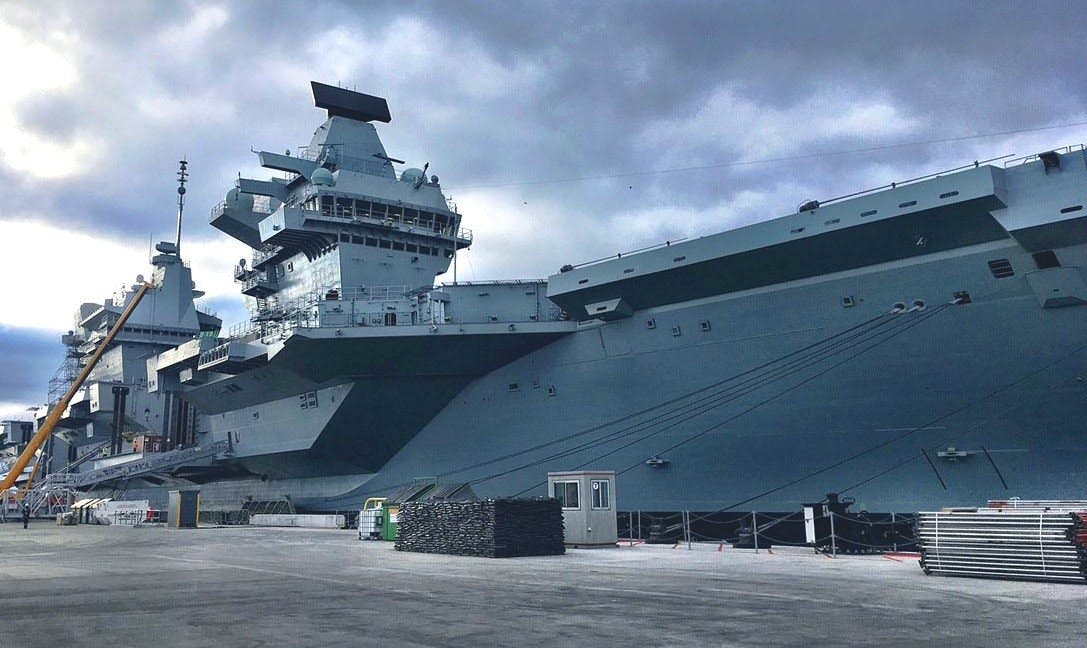











If SRVL is to be the preferred method of landing the F35B on the carriers, shouldn’t they have been built with an angled flight deck? As any abort currently would see them overfly aircraft waiting to take off.
Vertical landing is the preferred method. SVRL will only be used when needed in hot climates with heavy loads. It’s use will not be “common” except for training purposes.
And no, there will not be any aircraft on the runway ahead of the landing SVRL aircraft so your concern is misplaced.
I’m fairly certain SRVL is the preferred method? It brings back more weapons and fuel, and it puts less strain on both the aircraft and deck.
some pictures can be found on the of the q e class without the ramp, i think it looks a far better looking ship an angled deck from the stbd stern aft corner to a point above the port phalanx sponson may sreatch a few more yards for take off and recovery
Trivial.
‘ they will not feature any sort of missile based self-defence system aside from hosting containerised CAMM when required, according to Hansard and what I was told at Rosyth.’
While the carrying of containerised CAMM is an obvious step that I’ve seen mooted on a number of occasions, I have never seen it confirmed that this will actually happen . Do you have a link to support this claim as it would be step in the right direction.
Interesting, and along the lines of similar trials of HIMARS on U.S.S. Essex , and Iron Dome planned for Israeli Sa`ar 6. Also the naval application of Brimstone named `Sea Spear`.
A containerised `plug in and play` option.
At least it would be an option. It would seem strange for the only country(?) to have fired SAMs from a carrier in wartime (Invincible `82) to now be the only country operating carriers without them. Especially taking into account pressures on the RN escort force.
An inner ring of defence that you hope never to use should not mean not having it in the first place.
Maybe that tells you something, as it was soon after the falklands that they removed the air defence missiles. Maybe the RN learn a lesson others have not.
Let’s be honest if the RN really wanted a relatively cheap Point defence missile added to £6 billion of irreplaceable capital ships they would have got it.
Some time ago, a pratt from the MoD speculated it would be easy to have an army CAMM truck parked on the deck to provide a missile defence. Presumably he was later told to keep his mouth shut and ignorant opinions to himself.
it could be that additional sponsons may be needed to accommodate further systems
Thats because the QE2’s will not travel without a Point-defence destroyer (Type 45) which when combined with the anti-air capability of F35 offsets the need for space-consuming and costly anti-air missiles. Besides Phalanx CIWS can engage any target up to (correct me if I’m wrong) 9 miles away
Just over 2 miles max. Very very close and difficult for incoming hypersonic missile..impossible to take out multiple concurrent incoming HS missiles from same general direction.
‘The ships will be 280 metres long and up to sixty at full load or surge conditions’
I presume the words ‘and cancarry’ & ‘aircraft’ should be added.
Yawn. The reasons why have been well documented, explained, and are obvious if anyone understands how new ships like this work up prior to first deployment.
I for one am delighted and extremely proud the UK can build ships like this and people are STILL moaning.
Cor. Having re read this after a year HF I obviously missed your sarcasm.
My apologies.
I’m not the only one reading year old articles and comments!!!
No! I had noticed but keep checking to see how many post.
can carry !
When is HMS QE due to get her defensive weponary fitted?
Ones already fitted. The other two are due before she sails in November
Totally get the advantage of big carriers, fail to get the interoperability when in current format they can only operate one type of aircraft, limited capability AEW and ASW helicopters only.
Exacerbated by the reductions in other capability to support them. e.g reduced escorts and amphibious capacity.
Sortie Tate of big carriers and operational capacity has been well established since the 1950’s and likely before – with the introduction of the Midway class in 1945
Hope their are enough support vessels and DEFENCE vessels to look after these new Aircraft carriers. Know what amount of ships it took to look after the carriers in the Far East Fleet in 1958 to 1962
Still mentions “Wildcat HM2” in the Littoral Manoeuvre package. Why do you never correct your articles, this has been pointed out several times in previous articles? The LitM Wildcat of CHF’s 847 NAS are Wildcat AH1 variants. The Wildcat HMA2 variants belong to 815 and 825 NAS and are not LitM aircraft.
I think having the carrier sail without maximum amount of aircraft is stupid. The Americans don’t have a carrier deploy without anything short of wartime-surge numbers on board.
My ideal compilation would be: 30 F35’s, 10 Merlins (crows-nest/ASW), 4 Chinooks, 4 Apaches and even a couple of USMC MV-22 Ospreys. I think we should have more cross-cooperation with the Americans, they embark Ospreys with our carriers and we lend them some ASW/crows nest Merlins for example
We’ve got exactly the carriers we need. Important to have two of them so one is always available. That’s the big mistake the French made. Only building one.
This is most likely not going to be possible but is there any way I as a civilian with no connection to the armed forces can get a tour of this ship? Even just being on deck and maybe seeing the mess hall and the like would give a good idea of the physical size of this as it’s hard to get a real sense of the scale from pictures and video.
Keep your eyes peeled for port visits. RN ships are occasionally opened up to the public, mostly for ticketed free admission. Recent examples of this include HMS Medway and HMS Albion. Sometimes, if taking part in a festival, ships are also opened up. HMS Penzance took part in the Belfast Maritime festival and was open to the public free of charge, no ticket required.
Of course, I still think we should bring back navy days.
Does anyone know why hms prince of wales is bigger than hms queen elizabeth
It’s not that much heavier. The 3-4000 toonees comment is simply misinterpreted. It simply referred to the ship being heavier at the same point of construction as QE, showing that the ship was progressing faster due to the lessons learned in the build process.
POW is slightly heavier, likely die to some modifications such as the bedford array and LPH amendments which were made to the ship. These will be added to QE in the future.
Of course, QE has equipment which POW doesn’t yet have, including some landing aids and two phalanx guns – the other phalanx and four 30mm cannons have yet to be added to QE.
I think there are serious questions around whether the UK has enough escorts to undertake a global flag flying exercise and create a carrier battle group that is big enough to make a message/point (which ultimately is the main job of a carrier battle group). My feeling is the UK perceived strength globally was damaged in Iraq/Afgan and this is made worse by single (lets face it under-armed, as all the ships are) ships operating all over the place.
I really think to maximize the perceived threat of the carrier(s) we need to create a realistic battle group to go with them, including sufficient jets on board, escorts, troops etc.
Imagine if Iran had taken a US flagged merchant ship, the first thing they would do would position a strong carrier battlegroup off Iran to make their point clear, then they would start negotiating from a position of strength.
The QE/PoW should never leave port with less than 3-4 escorts, 20-30 jets and ideally a large force of marines either on board or on an albion. 1 or 2 escorts plus 12 or so jets just doesn’t make a point, if anything it just highlights how overstretched the royal navy is.